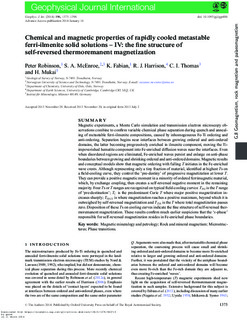| dc.contributor.author | Robinson, Peter | |
| dc.contributor.author | McEnroe, Suzanne | |
| dc.contributor.author | Fabian, Karl | |
| dc.contributor.author | Harrison, Richard J. | |
| dc.contributor.author | Thomas, Christopher Ian | |
| dc.contributor.author | Mukai, Hiroshi | |
| dc.date.accessioned | 2018-03-23T12:17:51Z | |
| dc.date.available | 2018-03-23T12:17:51Z | |
| dc.date.created | 2014-01-20T11:48:42Z | |
| dc.date.issued | 2014 | |
| dc.identifier.citation | Geophysical Journal International. 2014, 196 (3), 1375-1396. | nb_NO |
| dc.identifier.issn | 0956-540X | |
| dc.identifier.uri | http://hdl.handle.net/11250/2491927 | |
| dc.description.abstract | Magnetic experiments, a Monte Carlo simulation and transmission electron microscopy observations combine to confirm variable chemical phase separation during quench and annealing of metastable ferri-ilmenite compositions, caused by inhomogeneous Fe-Ti ordering and anti-ordering. Separation begins near interfaces between growing ordered and anti-ordered domains, the latter becoming progressively enriched in ilmenite component, moving the Ti-impoverished hematite component into Fe-enriched diffusion waves near the interfaces. Even when disordered regions are eliminated, Fe-enriched waves persist and enlarge on anti-phase boundaries between growing and shrinking ordered and anti-ordered domains. Magnetic results and conceptual models show that magnetic ordering with falling T initiates in the Fe-enriched wave crests. Although representing only a tiny fraction of material, identified at highest Ts on a field-cooling curve, they control the ‘pre-destiny’ of progressive magnetization at lower T. They can provide a positive magnetic moment in a minority of ordered ferrimagnetic material, which, by exchange coupling, then creates a self-reversed negative moment in the remaining majority. Four Ts or T ranges are recognized on typical field-cooling curves: TPD is the T range of ‘pre-destination’; TC is the predominant Curie T where major positive magnetization increases sharply; TMAX is where magnetization reaches a positive maximum, beyond which it is outweighed by self-reversed magnetization and TZM is the T where total magnetization passes zero. Disposition of these Ts on cooling curves indicate the fine structure of self-reversed thermoremanent magnetization. These results confirm much earlier suspicions that the ‘x-phase’ responsible for self-reversed magnetization resides in Fe-enriched phase boundaries. | nb_NO |
| dc.language.iso | eng | nb_NO |
| dc.publisher | Oxford University Press | nb_NO |
| dc.title | Chemical and magnetic properties of rapidly cooled metastable ferri-ilmenite solid solutions - IV: The fine structure of self-reversed thermoremanent magnetization | nb_NO |
| dc.type | Journal article | nb_NO |
| dc.type | Peer reviewed | nb_NO |
| dc.description.version | publishedVersion | nb_NO |
| dc.source.pagenumber | 1375-1396 | nb_NO |
| dc.source.volume | 196 | nb_NO |
| dc.source.journal | Geophysical Journal International | nb_NO |
| dc.source.issue | 3 | nb_NO |
| dc.identifier.doi | 10.1093/gji/ggt486 | |
| dc.identifier.cristin | 1094521 | |
| dc.description.localcode | © The Authors 2014. Published by Oxford University Press on behalf of The Royal Astronomical Society. | nb_NO |
| cristin.unitcode | 194,64,90,0 | |
| cristin.unitname | Institutt for geovitenskap og petroleum | |
| cristin.ispublished | true | |
| cristin.fulltext | original | |
| cristin.qualitycode | 2 | |
